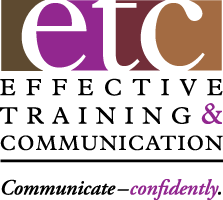Once you’ve defined your objects and analyzed your audience, the next step on your journey towards Audience-Centricity is to Develop Your Content. So, what’s your point? Really – what’s the key message you’ll be delivering that you want the audience to understand, remember and agree with after the presentation?
Your Main Point (MP) is the essence of your message, boiled down to one concise, specific, positive sentence. You should be able to write it on the back of your business card.
Everything you say will connect directly to your MP. It’s neither the topic of your presentation or its title. For example, my topic could be ‘ETC Sales Pitch’ and the title could be ‘Present with More Power and Success’, but my Main Point should be something like ‘ETC … an excellent resource for enhancing employee presentation skills.’
The audience will hear this MP at least once in the introduction, three or four times during the body of the presentation and one last time in the summary or conclusion. Studies regularly indicate that the more often the audience hears a point, the greater the chance they’ll remember it. That doesn’t mean they’ll believe it, just remember it.
If you’ve ever been in the audience when the speaker says ‘Today, I want to discuss five … seven … 10 points’, you probably started dreading the ordeal to come. One of the doctrines of Audience-Centricity is that ‘Less is More’, so one Main Point sounds a whole lot more bearable that a larger number.
The rest of your message becomes Sub-Points (SP), all connecting to and supporting the MP. These are key messages you must deal with to accomplish the goal of your MP – getting the audience to remember and believe it. And three SPs tend to be a manageable number – we can easily remember and tolerate three. Even if you had 10 separate concepts to share, you can repackage them with a spin so they turn into three.
Another Best Practice is to describe these SPs as questions. So, I could say something like ‘Today, we’ll be briefly discussing ETC… an excellent resource for enhancing employee presentation skills. To do that, let’s answer three important questions on your mind: ‘What is ETC?’, ‘How do we empower your colleagues to take the pain out of workplace presentations?’ and ‘Why should you partner with us?’
By phrasing SPs as questions, it implies that you’ve thoroughly analyzed what your audience (see my article ‘Know Your Audience‘) needs and wants and are prepared to deliver it. It also suggests that the presentation to follow will be more of a discussion, even if you do all the talking. Subtle concepts for sure, but they can have a positive impact on your audience and results.
Now, build out each SP with the facts, statistics, comparisons, expert quotes, references, examples, stories or anecdotes needed to effectively answer each question. But, remember your commitment to Audience-Centricity. Only mention what you think or know the audience needs and wants to know to answer each SP question. It’s all about what they want to hear, not what you want to say.
Also consider how you’ll summarize each SP and transition to the next. Most presenters typically connect points in a linear fashion – A to B to C. But Best-in-Class presenters embrace the value of reconnecting each SP back to the MP – A to MP to B to MP to C. It’s as if the MP was the hub of a wheel and each SP was on a spoke at the rim.
For example, I might summarize my first SP by saying ‘As you’ve seen, ETC is a highly respected and experienced communication specialty firm – your best resource for enhancing employee presentation skills. Now let’s move from ‘Who are we?’ to ‘How do we help your colleagues take the pain out of workplace presentations?’ So, we move from SP A back to the MP and then to SP B.
If you have any specific questions about this or other presentation-related topics, simply send me a note at phil@communicate-confidently.com. I’ll respond individually or comment on them in future E-Newsletters.
So, to create a successful Audience-Centric presentation, identify your Main Point and three Sub-Points in the form of questions that relate to it. Connect each Sub-Point back to the Main Point to make sure the audience hears it often. So … what’s your point?
